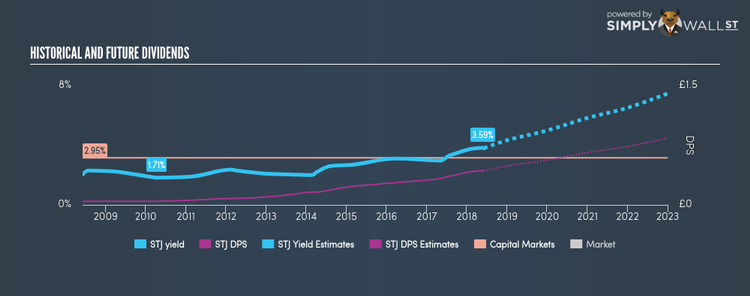Should St James’s Place plc (LON:STJ) Be Part Of Your Portfolio?

A sizeable part of portfolio returns can be produced by dividend stocks due to their contribution to compounding returns in the long run. Over the past 10 years, St James’s Place plc (LSE:STJ) has returned an average of 2.00% per year to shareholders in terms of dividend yield. Should it have a place in your portfolio? Let’s take a look at St. James’s Place in more detail. View our latest analysis for St. James’s Place
5 checks you should use to assess a dividend stock
When assessing a stock as a potential addition to my dividend Portfolio, I look at these five areas:
Is their annual yield among the top 25% of dividend payers?
Does it consistently pay out dividends without missing a payment of significantly cutting payout?
Has dividend per share risen in the past couple of years?
Is it able to pay the current rate of dividends from its earnings?
Will it be able to continue to payout at the current rate in the future?
How well does St. James’s Place fit our criteria?
St. James’s Place has a trailing twelve-month payout ratio of 154.02%, meaning the dividend is not sufficiently covered by its earnings. Going forward, analysts expect STJ’s payout to reduce to 90.03% of its earnings, which leads to a dividend yield of 4.79%. However, EPS should increase to £0.43, meaning that the lower payout ratio does not necessarily implicate a lower dividend payment. If there is one thing that you want to be reliable in your life, it’s dividend stocks and their constant income stream. STJ has increased its DPS from £0.04 to £0.43 in the past 10 years. It has also been paying out dividend consistently during this time, as you’d expect for a company increasing its dividend levels. These are all positive signs of a great, reliable dividend stock. Relative to peers, St. James’s Place generates a yield of 3.56%, which is high for Capital Markets stocks but still below the market’s top dividend payers.
Next Steps:
If you are building an income portfolio, then St. James’s Place is a complicated choice since it has some positive aspects as well as negative ones. However, if you are not strictly just a dividend investor, the stock could still offer some interesting investment opportunities. Given that this is purely a dividend analysis, I urge potential investors to try and get a good understanding of the underlying business and its fundamentals before deciding on an investment. I’ve put together three important factors you should look at:
Future Outlook: What are well-informed industry analysts predicting for STJ’s future growth? Take a look at our free research report of analyst consensus for STJ’s outlook.
Valuation: What is STJ worth today? Even if the stock is a cash cow, it’s not worth an infinite price. The intrinsic value infographic in our free research report helps visualize whether STJ is currently mispriced by the market.
Dividend Rockstars: Are there better dividend payers with stronger fundamentals out there? Check out our free list of these great stocks here.
To help readers see pass the short term volatility of the financial market, we aim to bring you a long-term focused research analysis purely driven by fundamental data. Note that our analysis does not factor in the latest price sensitive company announcements.
The author is an independent contributor and at the time of publication had no position in the stocks mentioned.

 Yahoo Finance
Yahoo Finance 
